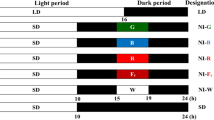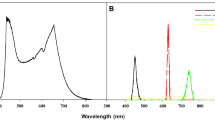Abstract
We investigated the effects of light quality during night interruption (NI) on morphogenesis, flowering, and the transcription of photoreceptor genes in the geranium Pelargonium × hortorum L.H. Bailey ‘Ringo 2000 Violet’ (day neutral plant, DNP). Plants were grown in an environment-controlled chamber under a constant light intensity of 180 μmol·m-2·s-1 PPF. The light was supplied by white (W) light emitting diodes (LEDs) to create long day (LD, 16 h light/8 h dark), short day (SD, 10 h light/14 h dark), or SD with a 4 h night interruption (NI) conditions. The NI was provided by green (NI-G), blue (NI-B), red (NI-R), far-red (NI-Fr), or white (NI-W) LEDs at a significantly reduced intensity of 10 μmol·m-2 ·s-1 PPF (only 5.5% of the intensity of the main light source). Plant height was greatest under NI-Fr. The percent flowering was not affected by light quality during NI, and all plants flowered under all treatments. Among NI treatments, days to visible flower buds (DVB) increased under NI-Fr. All photoreceptor genes except phyB and FTL were highly expressed under normal LD conditions. Under the NI treatment with different qualities of light, these photoreceptor genes were expressed at even higher levels, except under NI-B, as compared to SD. These results suggest that morphogenesis, flowering, and the expression of transcription factor genes are affected by light quality during NI. Light quality during NI in the DNP geranium has more pronounced effects on morphogenesis than on flowering.
Similar content being viewed by others
Literature Cited
Adams SR, Valdes VM, Langton FA (2008) Why does low intensity, long-day lighting promote growth in petunia, impatiens, and tomato? J Horticult Sci Biotechnol 83:609–615
Akoyunoglou G, Anni H (1984) Blue light effect on chloroplast development in higher plants. In H Senger, ed, Blue light effects in biological systems. Springer-Verlag, Berli, pp 397–406
Barreiro R, Guiamet JJ, Beltrano J, Montaldi ER (1992) Regulation of the photosynthetic capacity of primary bean leaves by the red:far-red ratio and photosynthetic photon flux density of incident light. Physiol Plant 85:97–101
Blanchard MG, Runkle ES (2009) Use of a cyclic high-pressure sodium lamp to inhibit flowering of chrysanthemum and velvet sage. Sci Hortic 122:448–454
Cosgrove DJ (1981) Rapid suppression of growth by blue light. Plant Physiol 67:584–590
Craig DS, Runkle ES (2016) An intermediate phytochrome photoequilibria from night-interruption lighting optimally promotes flowering of several long-day plants. Environ Exp Bot 121:132–138
Damann MP, Lyons RE (1996) Natural chilling and limited inductive photoperiod affect flowering in two Asteraceae genera. J Am Soc Hortic Sci 121:694–698
Dere S, Gunes T, Sivaci R (1998) Spectrophotometric determination of chlorophyll -a, b and total carotenoid contents of some algae species using different solvents. Turk J Bot 22:13–17
Dougher TAO, Bugbee B (2004) Long-term blue light effects on the histology of lettuce and soybean leaves and stems. J Am Soc Hortic Sci 129:497–472
Franklin KA (2008) Shade avoidance. New Phytol 179:930–944
Frechilla S, Talbott LD, Bogomolni RA, Zeiger E (2000) Reversal of blue light-stimulated stomatal opening by green light. Plant Cell Physiol 41:171–176
Hamamoto H, Hideo S, Tadahisa H (2005) Budding response of horticultural crops to night break with red light on alternate days. Environ Control Biol 43:21–27
Hanson HC (1917) Leaf structure as related to environment. Am J Bot 4:533–560
Hersch M, Lorrain S, Wit M, Trevisan M, Ljung K, Bergmann S (2014) Light intensity modulates the regulatory network of the shade avoidance responses in Arabidopsis. Proc Natl Acad Sci USA 111:6515–6520
Huq E, Al-Sady B, Hudson M, Kim C, Apel K, Quail PH (2004) Phytochrome-interacting factor 1 is a critical bHLH regulator of chlorophyll biosynthesis. Sci Signal 305:1937–1941
Kang KJ, Oh W, Shin JH, Kim KS (2008) Night interruption and cyclic lighting promote flowering of Cyclamen persicum under low temperature regime. Hortic Environ Biotechnol 49:72–77
Kim YJ, Lee HJ, Kim KS (2011) Night interruption promotes vegetative growth and flowering of Cymbidium. Sci Hortic 130:887–893
Monte E, Tepperman JM, Al-Sady B, Kaczorowski KA, Alonso JM, Ecker JR, Li X, Zhang Y, Quail PH (2004) The phytochrome-interacting transcription factor, PIF3, acts early, selectively, and positively in light-induced chloroplast development. Proc Natl Acad Sci USA 101:16091–16098
Muneer S, Kim EJ, Park JS, Lee JH (2014) Influence of green, red and blue light emitting diodes on multi protein complex proteins and photosynthetic activity under different light intensities in lettuce leaves (Lactuca sativa L.). Int J Mol Sci 15:4657–4670
Park IS, Cho KJ, Kim J, Cho JY, Lim TJ, Oh W (2016a) Growth and flowering responses of petunia to various artificial light sources with different light qualities. Korean J Hortic Sci Technol 34:55–66
Park YG (2014) Morphogenesis and flowering of photoperiodic floricultural plants in response to quality, quality shifting, and positioning of night interruption light., PhD Diss, Gyeongsang Natl Univ, Jinju
Park YG, Muneer S, Jeong BR (2015) Morphogenesis, flowering, and gene expression of Dendranthema grandiflorum in response to shift in light quality of night interruption. Int J Mol Sci 16:16497–16513
Park YG, Muneer S, Soundararajan P, Manivnnan A, Jeong BR (2016b) Light quality during night interruption affects morphogenesis and flowering in Petunia hybrida, a qualitative long-day plant. Hortic Environ Biotechnol 57:371–377
Park YJ, Kim YJ, Kim KS (2013) Vegetative growth and flowering of Dianthus, Zinnia, and Pelargonium as affected by night interruption at different timings. Hortic Environ Biotechnol 54:236–242
Possart A, Fleck C, Hiltbrunner A (2014) Shedding (far-red) light on phytochrome mechanisms and responses in land plants. Plant Sci 217–218:34–46
Oh W, Runkle ES (2016) Flowering and morphological responses of petunia and pansy as influenced by lamp type and lighting period to provide long days. Korean J Hortic Sci Technol 34:207–219
Quail PH, Boylan MT, Parks BM, Short TW, Xu Y, Wagner D (1995) Phytochromes: Photosensory perception and signal transduction. Science 268:675–680
Reddy SK, Finlayson SA (2014) Phytochrome B promotes branching in Arabidopsis by suppressing auxin signaling. Plant Physiol 164:1542–1550
Runkle ES, Heins RD, Cameron AC, Carlson WH (1998) Flowering of herbaceous perennials under various night interruption and cyclic lighting treatments. HortScience 33:672–277
Saebo A, Krekling T, Appelgren M (1995) Light quality affects photosynthesis and leaf anatomy of birch plantlets in vitro. Plant Cell Tissue Organ Cult 41:177–185
Senger H (1982) The effect of blue light on plants and microorganisms. Photochem Photobiol 35:911–920
Sims DA, Pearcy RW (1992) Response of leaf anatomy and photosynthetic capacity in Alocasia macrorrhiza (Araceae) to a transfer from low to high light. Am J Bot 79:449–455
Smith H (2000) Phytochromes and light signal perception by plants an emerging synthesis. Nature 407:585–591
Suarez-Lopez P, Wheatley K, Robson F, Onouchi H, Valverde F, Coupland G (2001) CONSTANS mediates between the circadian clock and the control of flowering in Arabidopsis. Nature 410: 1116–1120
Sun J, Nishio JN, Vogelmann TC (1998) Green light drives CO2 fixation deep within leaves. Plant Cell Physiol 39:1020–1026
Talbott LD, Nikolova G, Ortiz A, Shmayevich I, Zeiger E (2002) Green light reversal of blue-light-stimulated stomatal opening is found in a diversity of plant species. Am J Bot 89:366–368
Tepperman JM, Hudson ME, Khanna R, Zhu T, Chang SH, Wang X, Quail PH (2004) Expression profiling of phyB mutant demonstrates substantial contribution of other phytochromes to redlight-regulated gene expression during seedling de-etiolation. Plant J 38:725–739
Vandenbussche F, Pierik R; Millenaar FF, Voesenek LA, van Der Straeten D (2005) Reaching out of the shade. Curr Opin Plant Biol 8:462–468
Vince-Prue D (1975) Photoperiodism in plants.1st ed. MaGraw-Hill, London
Whitman CM, Heins RD, Cameron AC, Carlson WH (1998) Lamp type and irradiance level for daylength extensions influence flowering of Campanula carpatica ‘Blue Clips’, Coreopsis grandiflora ‘Early Sunrise’, and Coreopsis verticillata ‘Moonbeam’. J Am Soc Hortic Sci 123:802–807
Yue D, Gosselin A, Desjardins Y (1993) Effects of forced ventilation at different relative humidities on growth, photosynthesis and transpiration of geranium plantlets in vitro. Can J Plant Sci 73:249–256
Zeiger E (1990) Light perception in guard cells. Plant Cell Environ 13:739–744
Author information
Authors and Affiliations
Corresponding author
Rights and permissions
About this article
Cite this article
Park, Y.G., Muneer, S., Soundararajan, P. et al. Light quality during night interruption affects morphogenesis and flowering in geranium. Hortic. Environ. Biotechnol. 58, 212–217 (2017). https://doi.org/10.1007/s13580-017-0246-6
Received:
Revised:
Accepted:
Published:
Issue Date:
DOI: https://doi.org/10.1007/s13580-017-0246-6




